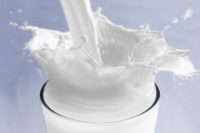
Promoting Probiotics
by Lori Dahm
A wave of dairy products is hitting shelves with these
live, active cultures.
For years, experts within
the dairy industry have been waiting for the potential of probiotics to
break wide open.
Several market factors indicated that probiotic
popularity was imminent, including the growing embrace of yogurt as
inherently healthy, the widespread acceptance of probiotics in Europe and
Asia, and the initial introduction of Dannon’s Actimel in 1999. In
addition, numerous research studies have demonstrated the significant
health benefits that probiotic cultures and prebiotic ingredients deliver.
But the probiotic possibilities have languished.
Consumers have not shown an interest in learning about ingesting good
bacteria or about the issues of gut health.
That is, until now, when a number of dairy products
with probiotic cultures are being introduced almost simultaneously. At the
same time, there has been increased publicity about the importance of
gastrointestinal health and more consumers are seeking health solutions
through food.
These signs point to probiotics finally coming into
their own, although a realistic forecast predicts several more years for
consumer awareness to build to a level where probiotics are thoroughly
understood and sought for their significant health benefits.
Gut Health
Probiotics are live microorganisms that are often
isolated from dairy products or the human or animal intestinal tracts, and
when consumed in adequate amounts result in health benefits.
Ingesting adequate amounts of probiotics can help
foster the proper bacteria balance in the human system and improve gut
health, and therapeutic doses of probiotics can also deliver health
benefits such as immune system enhancement.
“Although most consumers are not familiar with
the term ‘probiotics,’ the ingestion of live cultures is not
new. Yogurt is traditionally a source of live-active cultures — most
products contain probiotic cultures such as Lactobacillus acidophilus,”
says Dr. Beth Jones product manager for fresh dairy and probiotic cultures
at Danisco, Madison, Wis. “Yogurt manufacturers may not label these
products as containing probiotics. Yet consumers are already ingesting
live, active cultures in yogurt products and have had an introduction to
the concept. This is an excellent foundation to build consumer awareness
regarding probiotics.”
Often hand in hand with probiotics, prebiotic
ingredients are indigestible fibers that pass through the stomach to help
stimulate the activity of bacteria in the colon. These ingredients also
help boost calcium absorption, and are a natural combination with
probiotics.
In the past six months, several new products have
debuted in the market with specific probiotic label claims. The most
notable is Dannon’s DanActive, which was initially introduced five
years ago as Dannon Actimel.
Actimel existed in Europe for almost a decade, and was
introduced to the United States as a supplement in a drinkable yogurt
format. However, American consumers were not prepared to embrace the
Actimel concept readily, so Dannon went back to the drawing board, re-named
their product and adjusted the formulation slightly for the American
palate. The new DanActive product boasts 10 billion live and active
cultures.
Yoplait’s Nouriche product is another drinkable
yogurt with the label claiming live and active cultures. Lifeway Foods, the
leading producer of kefir in the United States, has introduced cultured
milk smoothies with “probiotic” front and center on the label.
And an interesting development is White Wave’s soy smoothie Silk
Live!, labeled “A live-cultured smoothie” that contains
probiotics with the claim “six live and active cultures.” The
time is at hand for products with probiotic ingredients to become a force
in the market.
“If you stop and think about what you have seen
in the media, in television commercials and such in the last year, there
are more ‘gut issues’ being given publicity,” says Jones.
“This is helping people become more comfortable with the topic of
their gut. Now people are understanding that gut health is important and
claiming ownership of it rather than avoiding it.”
Health Claims
When manufacturers first consider including probiotics
in their products, there are challenges in determining how to position
these products in the marketplace.
“It is necessary to develop the right lexicon to
talk to consumers about these organisms in terms they can understand, in
ways that are anecdotal rather than overly scientific,” says Bill
Haines, vice president of innovation at Dairy Management Inc., Rosemont,
Ill. “It is difficult to talk to consumers about live active bacteria
because a lot of the general public thinks bacteria are harmful rather than
helpful.”
Our society has become so focused upon eliminating
bacteria that educating consumers that probiotics are “good
bacteria” is a difficult proposition.
“Consumers would benefit from knowing that one
hypothesis for why we have so much allergy and inflammatory disease is due
to inadequate exposure to bacteria,” says Dr. Mary Ellen Sanders,
consultant with Dairy and Food Culture Technologies, Centennial, Colo.
“Not that you want to expose your children to pathogens, but we have
evolved in close concert with bacteria for hundreds of thousands of years.
Exposure to the right types of bacteria is a good thing, and imparting an
understanding of bacteria and probiotics would allow consumers to make more
educated choices for themselves.”
Although it may not be necessary for consumers to gain
a technical understanding of probiotic bacteria, some education is clearly
needed.
What might help in this realm is the completion of
human clinical studies with probiotic ingredients. Although many studies
have documented the health benefits of probiotics in reputable medical
journals, human clinical trials are still needed.
“The science is mounting steadily to prove the
numerous health benefits that probiotics can deliver, and we are seeing
research results that indicate that probiotic bacteria interact with immune
cells through the gut and deliver benefits in areas of immune
function,” says Sanders. “For example, several studies have
shown the ability of certain strains of probiotics to enhance overall
immune response to fight viruses and pathogens. An area of very promising
research is showing that probiotics can help offset gut inflammation or
irritable bowel syndrome.”
Other studies have indicated that probiotics may help
prevent colon cancer. And a recent study showed a 50 percent decrease in
incidence of atopic eczema in children at risk for the allergy who were
administered high doses of one probiotic at birth.
Studies of prebiotic ingredients demonstrate these
fibers have health benefits such as promoting gastrointestinal function,
reducing digestive illness and helping absorption of certain nutrients like
calcium and magnesium.
“Orafti conducted a study recently that showed
our inulin products not only protect the probiotic cultures through the
manufacturing process, but can also protect the probiotic through digestion
until the probiotic reaches the intestine,” says John Martin, project
leader at Orafti, Malvern, Pa. “Our findings were that inulin could
help promote the availability of probiotic bacteria in the gut.”
Human clinical studies are continuing to be conducted
to demonstrate the health benefits of probiotics.
“Some of the breaking studies demonstrate that
children eating milk with probiotics have a lower incidence of dental
carries, or that probiotics inhibit the Helicobacter pylori bacteria in the stomach. This bacterium is associated with
the development of ulcers and stomach cancer,” says Sanders.
“The vast health benefits can be understood by realizing the
potential for probiotic bacteria to impact human health is tied into all
the body areas that are colonized by microflora, and all the various
strains of probiotic organisms that exist — the potential is
huge.”
Tech Talk
The technical issues in including probiotic organisms
in dairy products center upon maintaining live active culture through the
product’s shelf life.
“In my opinion, there is a need for labeling the
probiotic with the types of bacteria and the final count that a product
delivers,” says Sanders. “This provides the consumer
information to judge the product’s value and also assurance that the
manufacturer is committed to deliver the efficacious levels of probiotic.
This is important for consumers to recognize the legitimacy of probiotic
products and embrace their health benefits.”
While fluid or fermented milk products provide a
friendly environment for bacteria to flourish, the high-acid environment
inherent in yogurt products can cause a reduction in the count of surviving
cultures. Manufacturers must determine the initial level of the probiotic
organism that should be added to achieve the count desired at the end of
the product’s shelf life.
“Dairy products are friendly to probiotic
cultures, however, we are starting to understand how formulations and
processing conditions impact the viability of these organisms through shelf
life,” says Jones. “These cultures are live biological systems,
and when you change the environment they have different reactions, so you
have to figure out how to keep that organism viable.”
The addition of a probiotic ingredient may cause the
characteristics of the product to change, so monitoring sensory differences
is necessary for success.
“A manufacturer may select probiotic strains to
include in their product depending upon the target population for the dairy
product and whether they want a single strain or a blend,” says
Jones. “In addition, certain probiotic strains will do better in
certain environments. Dairy products with a pH of 4 or below do best with a
L. paracasei strain.”
The technical issues with prebiotic fibers center upon
using the short-chain fibers versus the long-chain fibers for different
functional characteristics.
“High-acid systems like a soft drink will cause
a slight hydrolysis in inulin, but in yogurt and cultured dairy products
this is not a problem. However, it is important to keep in mind that
short-chain inulin acts more like a sugar versus long-chain inulin which
behaves more like a fat,” says Martin. “So a formulation might
use both fibers together if replacing the sugar with oligofructose while
trying to achieve the creamy mouthfeel that can be imparted with
inulin.”
It seems natural that probiotic cultures would be
included in dairy products because live cultures are inherent to
starter-fermented dairy products, and because refrigeration helps
probiotics survive.
How fermented dairy products may promote the survival
of the bacteria strains once ingested is the subject of current research.
One of the DMI-sponsored research projects being conducted at North
Carolina State University is investigating whether milk or milk components
affect the expression of key bacteria genes associated with probiotic
activity. The purpose is to determine which of the health benefits
associated with probiotics are likely maximized when cultures are consumed
with a dairy product.
While some of the more innovative dairy products that
include probiotics are cheese and dairy spreads like sour cream or cream
cheese, the inclusion of probiotics outside of dairy products is starting
to develop as well.
“The biggest area of concern when probiotics are
incorporated in non-dairy food applications is keeping the bacteria alive
in a food matrix that doesn’t have the benefit of refrigeration like
dairy products or an arid state like dry powders,” says Jones.
“To keep probiotics viable they must be kept in a semi-dormant state,
so moisture without refrigeration is problematic. Technology is currently
being evaluated in an attempt to create a system that maintains probiotic
survival in moist applications like nutrition bars, cookies, candy bars and
other products. The future will undoubtedly see this area
develop.”
With over 15 different commercial strains, research
also will continue to document the targeted health benefits that each
strain delivers.
“Probiotics have experienced growth and interest
for the last four or five years, and I expect this will continue with the
incorporation of probiotics into new dairy foods and in other food matrixes
outside of dairy,” says Jones. “New probiotic products will
also be targeting populations for specific health solutions. It is exciting
to be in this infancy stage where the marketplace is dynamic and
growing.”
$OMN_arttitle="Promoting Probiotics";?>
